
Venkateswara, also known as Venkatachalapati, Balaji and Srinivasa, is a Hindu deity, described as a form or avatar of the god Vishnu. He is the presiding deity of Venkateswara Temple, Tirupati. His consorts, Padmavathi and Bhudevi, are avatars of the goddess Lakshmi, the consort of Vishnu.
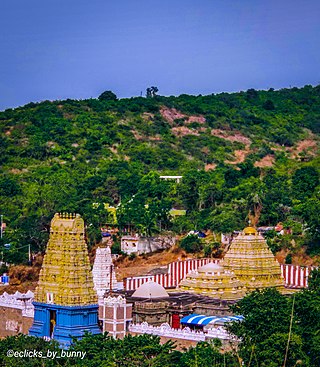
Sri Varaha Lakshmi Narasimha temple, Simhachalam, is a Hindu temple situated on the Simhachalam Hill Range,which is 300 metres above the sea level in the city of Visakhapatnam, Andhra Pradesh, India. It is dedicated to Lord Vishnu, who is worshipped there as Varaha Narasimha. As per the temple's legend, Vishnu manifested in this form after saving his devotee Prahlada from a murder attempt by the latter's father Hiranyakashipu. Except on Akshaya Trutiya, the idol of Varaha Narasimha is covered with sandalwood paste throughout the year, which makes it resemble a linga. The temple was built in Kalingan architecture styles and stands unique in the historical region of Kalinga.The Present temple was built by Eastern Ganga king Narasingha Deva I in the 13th century and consecrated by his son Bhanudeva I in 1268 CE. The temple was built by Akthayi Senapati, on the command of Narasingha Deva I.
Annavaram is a village in the Kakinada district of the Indian state of Andhra Pradesh, renowned for its religious and cultural significance. The village is best known for the Sri Veera Venkata Satyanarayana Swamy Temple, dedicated to Lord Satyanarayana, an incarnation of Vishnu. Situated on Ratnagiri Hill, the temple, constructed initially in 1891 and rebuilt in 1933–34, is a major pilgrimage site in Andhra Pradesh and is second only to the Tirumala Venkateswara Temple in terms of prominence. The temple's unique rituals, especially the collective Satyanarayana Vratam, attract thousands of devotees, particularly during the Karthika month.

Kumararama, also known as the Chalukya Bhimeswara Temple, is a historic Hindu temple located in Samalkota in the Kakinada district of Andhra Pradesh, India. Dedicated to Lord Siva, it is one of the five Pancharama Kshetras, revered pilgrimage sites in the state. The temple is renowned for housing a 14-foot tall white crystal Siva Linga, which spans two floors, believed to have been consecrated by Lord Kumara Swamy himself, giving the temple its name.

Kotipalli also known as Koti Theertham is a village located in K. Gangavaram mandal of Ramachandrapuram revenue division in Konaseema district of Andhra Pradesh, India. The temple town is also known as Kumararama of the Pancharama Kshetras, and is located 15 km from Amalapuram. Every year festivals such as Maha Sivaratri, Vaisakha Suddha Ekadasi, Aswayuja Suddha Padyami to Dwadasi and Ksheerabdi Dwadasi Teppotsavam are celebrated in this village.
Venkateswara Temple, Tirumala a landmark Vaishnavite temple situated in the hill town of Tirumala at Tirupati in Chittoor district of Andhra Pradesh, India. The temple is dedicated to Venkateswara, an incarnation of Vishnu, who is believed to be appeared here to save mankind from the trials and troubles of Kali Yuga.
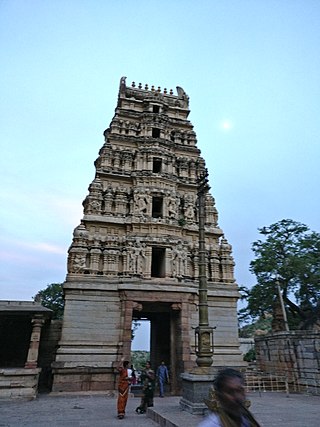
Yaganti Temple or Sri Yaganti Uma Maheswara Temple is a temple of Shiva in Nandyal district in the India state of Andhra Pradesh. It was built according to Vaishnavaite traditions.

Sapthagiri which is also called Tirumala Hill is situated in hill town of Tirumala, near Tirupati in the Tirupati district of Andhra Pradesh, India. This hill is 853 m above sea level and is about 10.33 square miles (27 km2) in area. It comprises seven peaks, representing the seven heads of Adisesha, thus earning the name Seshachalam. The seven peaks are called Seshadri, Neeladri, Garudadri, Anjanadri, Vrushabhadri, Narayanadri, and Venkatadri. The hill is famous for the famous and one of the most holy Hindu deity Venkateswara swamy temple. The temple is on Venkatadri, the seventh peak, and is also known as the "Temple of Seven Hills". The presiding deity of the temple is Lord Venkateswara, a form of the Hindu god Vishnu. Venkateswara is known by other names: Balaji, Govinda, and Srinivasa. The temple lies on the southern banks of Sri Swami Pushkarini, a holy water tank. The temple complex comprises a traditional temple building, with a number of modern queue and pilgrim lodging sites.
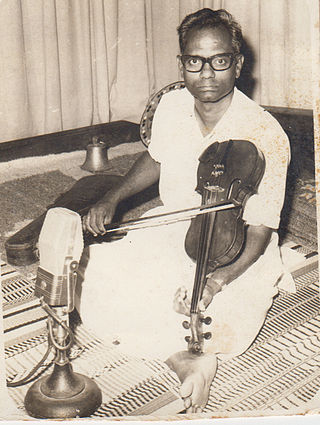
Malladi Venkata Satyanarayana Rao was a violinist and radio artist, honoured with the title Sangeetha Kalanidhi.
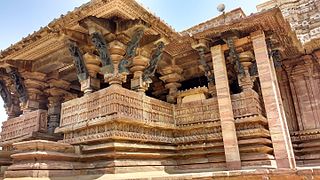
The earliest temples in Telangana include the Alampur Navabrahma Temples built during the 6th century CE by the Badami Chaulukyas.
Venkateswara Temple is an important Vaishnavite temple situated in the hill town of Tirumala in Tirupati of Andhra Pradesh, India. The Temple is dedicated to Venkateswara, an incarnation of Vishnu, who is believed to have appeared here to save mankind from the trials and troubles of Kali Yuga. The temple is situated at a height of 853 m (2,799 ft) on Tirumala Hills which are part of the Seshachalam Hills and is constructed in Dravidian architectural style.

The Kurmanathaswamy temple, also known as the Kurmanatha temple, Srikurma or Srikurmam temple, is a Hindu temple dedicated to Kurma – the second avatar of Vishnu. It is located in Srikurmam village, Srikakulam district in Andhra Pradesh, India. According to Prapannamrutam and earliest inscription of the temple, In saka 1035 CE Anantavarman Chodaganga Deva of Eastern Ganga Dynasty of Odisha converted this temple to a Vaishnava khetra from a Siva temple.The temple was Built before 11th-century CE in a fusion architecture of kalinga Architecture and Dravidian Architecture. The temple's perambulatory were constructed by Eastern Ganga Dynasty king Anangabhima Deva III, and it is dedicated to Vishnu as Kurmanathaswamy and his consort Lakshmi as Kurmanayaki. The temple has century old Orissan Pattachitra style mural paintings in side wall of pradakshina mandapa.
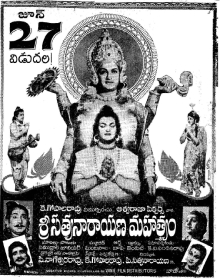
Sri Satyanarayana Mahathyam is a 1964 Indian Telugu-language Hindu mythological film directed by S. Rajinikanth. It stars N. T. Rama Rao and Krishna Kumari, with music composed by Ghantasala.

Vishaka Sri Sarada Peetham, also called the Sarada Peetham is a Hindu institution, located in Chinnamushidiwada, Visakhapatnam, Andhra Pradesh. It's dedicated to goddess Raja Shyamala Devi and Sri Sharada.
Sri Santhana Venugopala Swamy is an ancient Hindu temple in Thettu Village, Kurabalakota Mandal, Chittoor district, Andhra Pradesh. The Lord Venugopala Swamy Temple and Goddess Paleti Gangamma Temple are the places of worship in the village of Thettu. This deity is also known as Bala Gopala, Hucchu Gopala, or Sri Santana Venugopala.
Talupulamma Temple is a Hindu pilgrimage site located in the village of Lova in Kakinada district of Andhra Pradesh, India. The presiding deity is a gramadevatha known as Talupulamma Thalli.
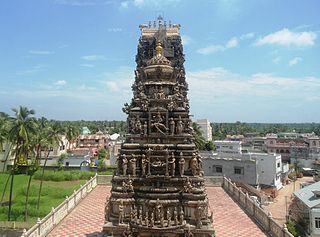
Kodandarama Temple is a Hindu temple located in Gollala Mamidada in Kakinada district of Andhra Pradesh, India. The temple is dedicated to Rama, the seventh incarnation of Vishnu. It was built on the banks of Tulyabhaga (Antharvahini), a tributary of Godavari.
Sri Bhavanarayana Swamy Temple is a historic Hindu temple dedicated to Lord Vishnu, located in Sarpavaram, approximately 5 km from Kakinada in Andhra Pradesh, India. The temple is recognized as one of the State Protected Monuments by the Archaeological Survey of India (ASI) in Andhra Pradesh and is renowned for its religious significance and historical inscriptions.
Sri Mandavya Narayana Swamy Temple is a historic Hindu temple dedicated to Vishnu located in Samarlakota of Kakinada district, Andhra Pradesh, India. It is situated near the Pancharama Kshetra of Kumararama in the Chalukya Bhimavaram suburb of Samarlakota. Known for its spiritual and historical significance, the temple attracts numerous devotees, particularly during festivals and rituals.
Sri Srungara Vallabha Swami Temple is a historic Hindu temple located in Chadalada Tirupati village in Kakinada district, Andhra Pradesh, India. The temple is dedicated to Sri Srungara Vallabha Swami, a manifestation of Lord Venkateswara, and is notable for its historical and architectural significance.































